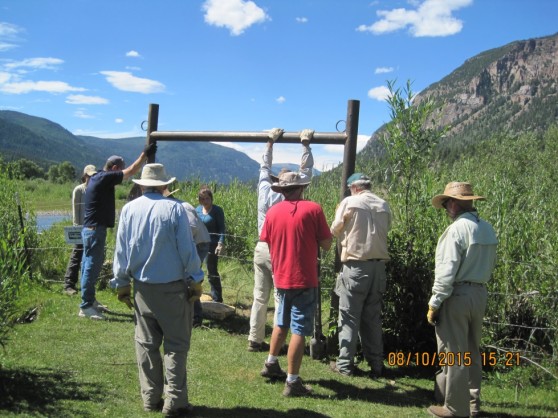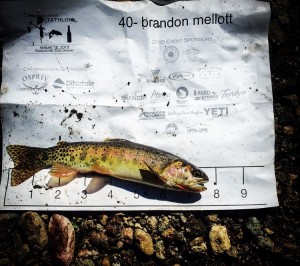Do you enjoy taking a kid fishing? How about helping them learn about stream ecology and what makes for healthy watersheds? Or engaging college students with service learning projects to help Colorado streams? If this sounds like you, you just might be a candidate for Colorado Trout Unlimited's Youth Education Coordinator. Colorado TU is seeking qualified applicants to manage our various programs for connecting kids with the great outdoors. Click here to see the job description. Applicants should submit their resume and letter of interest to Colorado TU via email to dnickum@tu.org, by October 5.
Bash 4 Boulder Creek supports stream restoration project
Mid-June, while many local streams were in full run-off, over 200 fishing and conservation enthusiasts gathered at the Rep Your Water headquarters to celebrate RepYourWater’s four-year anniversary and kick off the Boulder Flycaster’s latest project: The Flatirons Park Stream Restoration Project. The Bash 4 Boulder Creek was a blast - if you weren't there, you missed a great party for a great cause!
The party was held at Rep Your Water’s hangar on the edge of the Erie Municipal Airport  tarmac. The hangar had outstanding views of the June thunder storms forming over the Front Range. There was plenty of beer provided by Avery Brewing, great food from The Post and Old Wisconsin, an outstanding raffle, and party guests of all ages to make it a really fun event! Even more fun, especially for the kids, was the unexpected landing of a helicopter while local country band “Dusty Catfish” kept on playing.
tarmac. The hangar had outstanding views of the June thunder storms forming over the Front Range. There was plenty of beer provided by Avery Brewing, great food from The Post and Old Wisconsin, an outstanding raffle, and party guests of all ages to make it a really fun event! Even more fun, especially for the kids, was the unexpected landing of a helicopter while local country band “Dusty Catfish” kept on playing.
RepYourWater is a Boulder County based outdoor apparel company. Started four-years ago by husband and wife team Corinne and Garrison Doctor the company has incorporated conservation in their business since day one. Corinne states that “Businesses, no matter how small, need to take a stand a provide support for the protection of the natural world around us.” The company donates at least 1% of sales to Colorado Trout Unlimited, TU Chapters, and other conservation groups throughout North America. Additionally, RepYourWater regularly releases designs supporting specific conservation projects and/or issues. For the Bash 4 Boulder Creek, RepYourWater designed a limited edition hat, donated by Boulder’s Anthem Branding. The sharp looking hat features the Flatirons and a Boulder Creek brown trout. 100% of proceeds from the hat sales and the event went to support the Flatirons Park Project.
The Flatirons Park Stream Restoration Project seeks to rehabilitate and improve trout habitat on Middle Boulder Creek from Foothills Parkway to the BNSF railroad bridge. While the Boulder Flycasters were applying for funding to improve this reach, RepYourWater by coincidence had just adopted the same area of Boulder Creek. From day one, RepYourWater has been an enthusiastic supporter of the Flatirons Park Stream Restoration Project. "Corinne and I are both Boulder natives, so Boulder Creek has been and remains an integral part of our fly fishing landscape. It is an undervalued fishery and I am so excited to help the water that I grew up fishing" says Garrison. This reach of stream is currently overwidth, filled with sediment from the 2013 flood, and lacks good winter habitat. The Boulder Flycaster’s recently received a Fishing is Fun Grant to begin work on this often overlooked section of stream and has been seeking matching funds to get equipment in the creek and begin work. The Flycaster’s look forward to greatly improving the fishery’s quantity, quality, and over wintering capability.
For more info on Rep Your Water, and to see their great looking apparel check out repyourwater.com. For more information on the Flatirons Park Stream Restoration Project and to learn how you can support Boulder Flycaster’s efforts to improve this stretch of stream visit boulderflycasters.org. Hopefully we’ll see you at Bash 4 Boulder Creek version 2.0 next summer!
Hidden Mile of the Conejos
The San Luis Valley Chapter of Trout Unlimited (SLVTU) has been working on a Fishing is Fun project on the Hidden Mile along the Conejos River in cooperation with the US Forest Service (USFS), Colorado Parks and Wildlife (CPW), Conejos River Anglers Fly Shop and FlyWaters Inc.
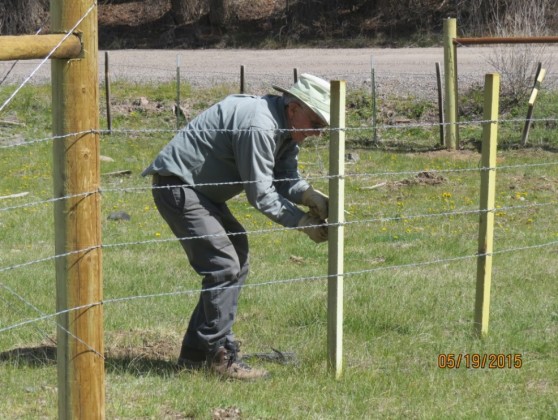
It has taken several years for project leader, David Kenvin and other volunteers to get grants, permits and environmental statements. But this summer the actual work commenced. The project consists of stream and riparian improvement of 3/4 of a mile of the Conejos River on Rio Grande National Forest property. The fish habitat has been degraded from years of trespass grazing. The project includes placement of 300 rocks and twenty wood structures, the improvement of pool and riffle ratios by channel dredge and fill, construction of a parking lot, fencing the entire property to exclude livestock and planting willows to stabilize stream banks.
The total project cost is $96,000 with SLVTU providing $20,000 in cash and volunteer labor worth over $7,800. Conejos River Anglers will provide $500 for signing. The USFS is providing fencing material and more than 200 hours of labor. A $67,000 grant from CPW’s Fishing is Fun Program completes the project’s funding. CPW and FlyWaters Inc. will be coordinating the stream improvement portion of the project which is timed for the last two weeks of September 2015.
SLVTU is a small chapter of just over a hundred members. Money needed for the cash contribution was raised through our annual auctions and donations from the Conejos River Anglers Super Fly contest. This spring and summer, several volunteers have given more than 425 hours of work building 4-strand barbed wire fence surrounding the riparian zone and floating PVC river-crossing fence at the lower and upper ends of the Hidden Mile. In the spring of 2016 we anticipate another 90 hours of volunteer work in planting willows along the stream to complete the project.
George is a Sleeper
Moose stands in the wallows and wet of George Creek
Not too long ago I was able to scout some new greenback territory with two colleagues. Upon arrival at George Creek we promptly stretched and yawned then headed to see the stream. It appeared to be a disappointing trickle surrounded by cattle, moose and dense vegetation. We stood, looking at the stream, wondering, who chose this creek and why.
The following Tuesday, in a meeting with Boyd Wright, a Native Aquatic Species Biologist with Colorado Parks and Wildlife we got our answer. Boyd was able to shine new light on George by explaining the details of the stream. George Creek sits at 9000 feet and has an easy gradient over about six land miles to it's confluence with Cornelius creek- most streams being looked at for greenback restoration are at 10000 ft or higher. Because of the easy gradient and elevation George Creek holds a consistent temperature above its high mountain counter parts. The temperature and elevation duo make George a well above average home for greenbacks.
With temperature and elevation taken care of, the next and most important question to ask is, did greenbacks originally inhabit this area of our state? Yes. The primary aspect of George is its location, after its confluence with Cornelius Creek it flows into the Cache La Poudre, from there its waters eventually wind their way to the South Platte, placing it squarely in the greenbacks native range. So although George may look like a challenging reintroduction site it offers up a robust ecosystem with many benefits. With our doubts eased we left the meeting satisfied with George Creek.
The road to George is a rocky one, literally. Windy, narrow, heavily forested, four wheel drive roads ensure your average sedan driving suburbanite is unable to access the miles of the moose ridden trout stream that is George Creek. With trucks and volunteers, Colorado Parks and Wildlife plan to build many fish barriers in George Creek to prevent nonnative fish from reentering the stream and to prevent the spread of whirling disease to the upper reaches of the creek. Without these barriers, nonnative brook trout would compete with the native cutthroat. Likewise, if whirling disease were to spread up stream it would wipe out the entire population of stocked greenbacks.
The barriers will do an adequate job of keeping the disease from moving up stream via fish, but it can also be spread by humans on dirty gear. It is important to take the proper precautions before recreating in the stream; be sure all of your gear is clean and dry and you walk from the headwaters of the stream down. To find information on cleaning gear see the Colorado Parks and Wildlife Angler Cleaning Card.
George Creek may not be seen as a divine ecosystem for greenbacks but given the current portfolio of streams for greenback restoration, it does provide the necessary diversity in habitat. Recruitment in the stream may be minimal per mile but with many miles of stream and a higher temperature range, along with lush riparian habitat to provide vibrant insect life, the stream makes it a livable home for the greenbacks.
Not to mention a nest egg for research biologists to study for years to come.
Tell Congress: Support Public Lands and Recreation
If Congress doesn't act this month, one of our nation's most successful public lands and recreation programs will come to an end. From the Great Sand Dunes, to access on the Colorado River, to community parks and trails in our own backyards, the Land and Water Conservation Fund (LWCF) has set aside and protected special places in Colorado and nationwide for the past 50 years.
A new Colorado TU report highlights the diverse benefits LWCF has provided to our state, from expanding hunting and angling access, to securing iconic landscapes like the Great Sand Dunes, to conserving private lands through conservation easements and partnerships. You can read the report here.
Yet this successful program is set to expire on September 30 if Congress doesn't act to extend it. Please ask your Senators and Representative - today - to support permanent reauthorization of LWCF and keep its benefits flowing to our public lands and our multi-billion-dollar outdoor recreation economy.
Click here to visit our online action alert where you can share your comments with your elected officials. Thank you!
TU Report: LWCF Benefits Colorado's Great Outdoors
In 1964, Congress created the Land and Water Conservation Fund (LWCF) to protect natural areas, water resources, and to provide recreation opportunities to all Americans. In its 50 year history, the LWCF has protected land in every state and helped support over 41,000 state and local parks. It has invested in public lands like Rocky Mountain National Park as well as supporting local community recreation resources and parks, cultural heritage sites, and working landscapes.Yet the authorization for this successful program expires on September 30, 2015 - and Congress has not yet acted to extend it. On July 30, the Senate Energy and Natural Resources Committee voted to send a bipartisan energy bill to the full Senate, but it still awaits that Senate vote. (Click here to contact your representatives today and urge them to support the LWCF.)
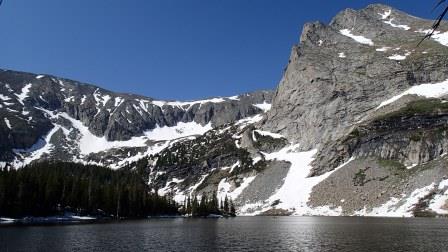
In Colorado, 77 percent of people are in support of the LWCF, the highest of any state.
Colorado has received $239 million in funds that have helped protect many state treasures like the Great Sand Dunes, Ophir Valley and Mesa Verde National Park- where $8.8 million in funds assisted in adding over 10,000 acres to the park since the year 2000. In return, outdoor recreation generates roughly $34.5 billion annually for the state.
To provide funds for recreation, LWCF uses revenues that stem from offshore oil and gas companies. Over $900 million is paid in royalties every year by these energy companies. However, in 50 years the LWCF has only been fully funded once, with Congress typically diverting some of the funds to other purposes.
While the LWCF has been an undisputed success in protecting public lands and promoting outdoor recreation, the program remains little known to many in the general public. To help tell some of the LWCF's Colorado success stories, Colorado TU has issued a report: Colorado's Great Outdoors - The Land and Water Conservation Fund in Colorado (click to open the report as a PDF file). Some examples of LWCF benefits to Colorado highlighted in the report include:
Fishing access & flood recovery. In 1976 when the Big Thompson River was 19 feet above its normal level, lives, homes and businesses were all lost. In the aftermath of the flood, the county went to the LWCF for just over $1 million in funds that the state would then match. With the new funds the County acquired 80 key properties along the Big Thompson for parks and angling access - properties that were not redeveloped and, when the river flooded again in 2013, helped avert an estimated $16 million in property damages.
The Town of Lyons was in a similar circumstance when the floods of 2013 hit. On September 12, the St Vrain Creek was flowing at 19,500 cubic feet per second- normally averaging at 67 CFS in September. The devastating floods caused damages of roughly $50 million and wiped out 39 acres of major park facilities- the main source of revenue for the town. Funding from the LWCF will help rebuild and extend the St Vrain Corridor Trail that provides recreational access along the St Vrain Creek.
Protecting iconic landscapes. President Herbert Hoover designated the Great Sand Dunes a national monument in 1932, but it would take nearly 70 years for the land to be recognized as a national park following the acquisition of the Baca Ranch. The designation was a direct result of grassroots efforts by residents of the San Luis Valley who recognized the unique landscape and the need to preserve it. The Great Sand Dunes, Baca National Wildlife Refuge, and the adjacent public lands all have benefited from LWCF funds in the past including with the critical initial acquisition of the Baca Ranch for the creation of the national park and preserve. Furthermore, Great Sand Dunes, Baca NWR, and the surrounding public lands have inholdings throughout the area, making management sometimes difficult because of the noncontiguous land pattern. LWCF funds have been used in the past to acquire some of these inholdings, easing management headaches and preserving this unique landscape.
According to surveys, 81 percent of voters approve of new land protection funding. In Colorado, Senators Michael Bennett and Cory Gardner are in full support of reauthorizing the LWCF to protect natural landscapes across the country for years to come. Members of Colorado’s House delegation are split on the issue.
Please visit the Action Center and urge your elected officials to reauthorize the LWCF!
A Trip To Zimmerman
Summer is ending, as we get ever closer to fall and winter our minds start to turn away from fishing toward the ski slopes. As summer is not quite over yet I think a couple more trips could be in order. Zimmerman Lake is a high mountain body of water nestled in a mountain bowl. It is surrounded by acres of National Forest, rimmed by scree fields that transition into craggy peaks that seem to kiss the clouds. The beauty of the place is not its most redeeming character though. Zimmerman is home to the only population of stocked greenback cutthroat trout in the nation. These fish represent the first step in greenback restoration across the state.

The greenbacks in Zimmerman are part of ground breaking genetic science that has never been seen before in the trout world. Right now the fish in Zimmerman are being weeded out by nature, any deformities, abnormalities or sickened fish will eventually die. This leaves only the fittest fish, these will be retaken and their genes will be analyzed to ensure breeding in captivity is as effective as possible. The genetic work surrounding the greenbacks is groundbreaking, by selectively breeding the fish biologists are attempting to steer greenbacks away from a genetic bottleneck.
There is one inflow stream coming into Zimmerman, it is not large but it does offer adequate habitat for spawning trout. In the spring greenbacks make their way up the stream to spawn, they return to the lake after eggs have been fertilized and fatten up the rest of the summer. Depending on the snow pack emerging fry swim down into the lake from mid October to November. By this time the summer has come to a close and food has become scarce, adult greenbacks in Zimmerman are eager for a free meal. When the fry enter the lake most, if not all, are eaten. The tiny inflow stream that brought the fry life delivers them as dinner to a waiting crowd of hungry mature greenbacks.
Fishing for these mature greenbacks is legal and easy. Zimmerman Lake is about a two and one half hour drive from Denver followed by a one mile hike from the parking lot. When at the lake pick up trash, fish with crimped barbs and respect other lake goers. Some effective flies are small streamers, small dark nymphs fished with an indicator, and the occasional hopper. It is important to fill out a catch card on the way out as these give Colorado Parks and Wildlife information on the usage of the area. Enjoy the fishing and the fish at Zimmerman because both are one of a kind.
Be sure to follow the greenbacks journey by visiting CTU's Greenback Recovery Efforts page here or at http://coloradotu.org/greenback-recovery-efforts/
Learning by Doing Seeks Coordinator
The Learning by Doing (LBD) Cooperative Effort represents a unique partnership program between East and West Slope stakeholders in Colorado. LBD is, in essence, a monitoring and adaptive management program with the goal of maintaining, and where possible, improving the health of Colorado River headwater streams in Grand County. As described in more detail below, LBD reflects an entirely new approach to managing water resources through innovation, collaboration and broad stakeholder involvement. The LBD Committee has an immediate need for a qualified candidate to serve as the Committee Coordinator. By providing organizational and administrative support, the Committee Coordinator will facilitate the achievement of the LBD Committee’s goals. The Committee Coordinator’s duties include, but are not limited to: working closely with Committee members; arranging meetings; taking/distributing notes; ensuring tasks are completed; assisting with public outreach efforts; updating the project web site; accounting; fund raising and other coordination duties. This is a contract position, requiring an average of approximately 15 hours per week. Regularly scheduled LBD meetings are typically held in Grand County or Denver, requiring some travel and flexibility. This contract position is being funded through a grant in the amount of $30,000 per year for a period of four (4) years. Contingent on funding, the duration of this position could be extended beyond four years. Trout Unlimited is the grantee and will manage the funds under the terms of the grant for the benefit of the LBD Committee. There is no permanent office or work space associated with this position. The compensation package does not include benefits.
Background on Learning By Doing The Upper Colorado River system and the Fraser/Williams Fork rivers provide important aquatic habitat and serve as a critical municipal, agricultural, recreational and industrial water supply for the state as a whole. A substantial percentage of the native flows of the Colorado, Fraser and Williams Fork rivers is currently diverted for Front Ranger water supply projects, and as a result, the health of the rivers has declined over the years. Two projects will divert additional native flows from these rivers across the Continental Divide to meet growing municipal needs of the Front Range: the Windy Gap Firming Project and the Moffat Collection System Project. Although these two projects triggered conflicts between West Slope and East Slope entities, years of negotiation produced the 2012 Colorado River Cooperative Agreement (CRCA), which establishes a long‐term partnership between Denver Water and the West Slope. The CRCA is a framework for numerous actions to benefit water supply, water quality, recreation, and the environment on both sides of the Continental Divide. The LBD Cooperative Effort emerged from the CRCA. The municipal sub‐district of Northern Water (Sub‐district) has a similar agreement between it and the West Slope which solidifies the Sub‐district’s commitments to benefit the aquatic ecosystem within Grand County.
The LBD Committee is composed of representatives from the following organizations: Colorado Parks and Wildlife, Denver Water, Northern Colorado Water Conservancy District, Grand County, Colorado River Water Conservation District, Middle Park Water Conservancy District, and Trout Unlimited. Other parties participating in LBD include the Bureau of Reclamation, Forest Service, water utilities, and other interested parties. The overall success of LBD in meeting its goals will be measured by the LBD Committee through resource monitoring and reporting. Long‐term success will also be measured by the extent to which the LBD model is adopted in other places, and the extent to which it is integrated into future water leadership training.
Education & Experience Graduation from a four‐year accredited college or university, preferably with a B.A./B.S. in natural resources, hydrology, biology or related field. A keen interest in water resource management, and familiarity with non‐profit organizations and stakeholder involvement and fund raising is a plus.
Required Skills & Abilities
* Sound project management principles and practices. * Ability to communicate clearly with LBD Committee members on both technical and administrative issues. * Proven written and verbal communication. * Strong time‐management. * Ability to use independent judgment in daily responsibilities. * Work effectively under deadlines.
Applying Submit resumes and cover letters by September 23 to: Jason Marks Environmental Planner 1600 12th Avenue Denver, CO 80204 jason.marks@denverwater.org
Rocky Mountain Flyathlon
On paper, there is nothing exceptional about Middle Creek. It is not Wild or Scenic, nor has it been bestowed with any Gold Medals or Blue Ribbons. No, on paper, Middle Creek is just like the countless other small tributaries that make up Colorado’s headwaters, an arteriole of our vast hydrologic circulatory system. These humble creeks quietly feed the streams that feed the rivers that feed our Colorado way of life. To get to these waters, you have to drive on paved roads until you get to dirt roads until those dirt roads narrow and then run out. Even then, to truly appreciate the complexity of these creeks, you will still have many miles to go, on foot, on trails that may not have been maintained in a while. You will encounter ticks, mosquitoes, stinging nettle, rattlesnakes, moose, bear, downed trees, and sketchy creek crossings. But if you are patient and dedicated, you can catch and release a spectacular relic of Colorado’s natural history, one of our three remaining sub-species of cutthroat trout. It is the celebration of these unheralded streams, lost trails and majestic native fish that drove me to create the Rocky Mountain Flyathlon. As a trail runner and life-long flyfisherman, fusing the two disciplines seemed natural to me, as trail running allows me to explore and fish our remote cutthroat waters more comprehensively. And then, back at the trailhead, to make it a proper celebration, I add one of the finest uses of Colorado water; our superior craft beer.
run. fish. beer.
Simple as that.
Three years ago, I decided to share this vision with others. In 2013, fifteen people crawled out of their tents to participate in an “unofficial” Flyathlon race event held around Monarch Lake in Grand County, CO. In 2014, we made it official, and thirty-five people toed a shoe-drawn line in the dirt at the base of Middle Creek (yes, the one with ticks and rattlesnakes). And this year, just weeks ago, our sold-out race brought fifty flyathletes from both near (Crestone and Salida) and far (Maine, Wisconsin, and Texas) to the Middle Creek woods near Saguache, CO.
Flyathlon race-day rules are fairly simple. Complete the prescribed trail run, catch a fish at any point during the run, take a picture of said fish on your race bib, and do it all as quickly as possible. The bigger the fish, the more time is taken off at the end of your run (with a special double bonus for catching a native cutthroat trout). In 2015, of the fifty race participants, all but four hooked, landed, and documented their catch, some for the first time ever. And back at our tent city, all fifty enjoyed BBQ, local craft beer, and an awards ceremony loaded with prizes from local Colorado companies thanks to Osprey Packs, Scott Fly Rods, Ascent Fly Fishing, and Rolling River Anglers.
Each Flyathlon race is specifically designed to get people excited about recreating in the most beautiful parts of the Western United States, to infuse the stuffy old sport of fly fishing with a youthful spirit, and to raise money for and awareness about critical cold-water conservation issues. Relying on a crowdfunding model with our 501c3 partner Colorado Trout Unlimited, this past year, our flyathletes raised an incredible $22,200. At least 50% of this money will be re-invested into projects to maintain and enhance the trails, creeks and fisheries within the range of the Rio Grande cutthroat trout, ensuring that our activity is sustainable into the future. The remaining monies will be used to tackle important coldwater and native fish issues around the Centennial State.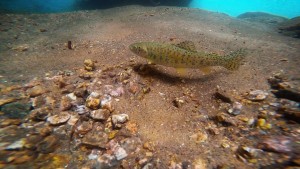
Moving forward into 2016, I hope to take the Flyathlon to the next level. With my outstanding volunteer planning board, I have created an ambitious agenda with additional events added in several other basins in Colorado, as well as potential out-of-state races. If you feel like you have what it takes to be a flyathlete, please visit our website www.flyathlon.com to get on our email list. If your organization would like to partner with or sponsor the Rocky Mountain Flyathlon to enable us increase our impact, please contact me directly atcutthroat@gmail.com.
I look forward to seeing you on a small creek somewhere deep in the Colorado woods.
run. fish. beer.
Words and photos courtesy of Andrew Todd
CTU Meets the World: Family Fly Fishing Festival
It's a beautiful, warm day in August at Nova Guides Lodge, or at least it was on August 15th when families, competitors and staff from the World Youth Fly Fishing Championships all gathered there for the Colorado TU co-sponsored event: the Family Fly Fishing Festival and Conservation Symposium. This past Saturday, the Lodge at Camp Hale was filled with a plethora of people milling about enjoying all that the event had to offer. The stunning scenery and temperate climate allowed for fly fishing to take precedence over almost everything else; although, Garrett Hanks, CTU's coordinator for the event, made sure there was something for everyone. Entomology, fly tying, fish art, and a conservation symposium, during which Holly Loff, Kendall Bakich, and Marcus Selig spoke on pertinent conservation issues, were the other activities offered.

The festival activities were not the only thing the attendees enjoyed, many were also pleased to see kids and adults alike interacting with each other in such a positive manner. "Fly fishing can be very bonding," one staff member of FIPS Mouche, the International Sport Flyfishing Federation, said. "It builds friendships." That's just one of the many benefits of having an event like this. The conservation symposium in combination with fly fishing and other activities allowed people to come together to share a common interest as well as learn something new.
The conservation focus of the symposium was on recovery of the Eagle River from its legacy of habitat damage and mine pollution - an issue made more poignant by the recent Gold King Mine spill on the Animas River. Holly Loff from the Eagle River Watershed Council spoke on an equally damaging spill from the Eagle Mine that occurred in the 80's. Years after the mine closed, it flooded over into the Eagle River causing a disaster even more striking than the one recently on the Animas River. Although the results of the spill was devastating, Loff emphasized the successful steps that were taken to bring the trout back to the Eagle River, and hopes to see the same thing happen with the Animas River. Kendall Bakich from Colorado Parks and Wildlife discussed how crucial it is to monitor fish health in order to restore fish populations to a healthy, normal range. Marcus Selig added an update on efforts to complete a major riparian and wetlands restoration program in Camp Hale. The speakers were an important part of the event, not only because they shined a positive light on an otherwise bleak situation, but because they further demonstrated how conservation and fly fishing go hand in hand. After all, we wouldn't have beautiful places to fish in if we didn't put in a conscious effort to conserve them.
The Family Fly FIshing Festival and Conservation Symposium was just one part of the larger events surrounding the 2015 World Youth Fly Fishing Championships. Team USA didn't let their "home water advantage" go to waste and successfully defended their team gold medals. Check out the feature in Colorado Outdoors for more on the Youth Championships.






